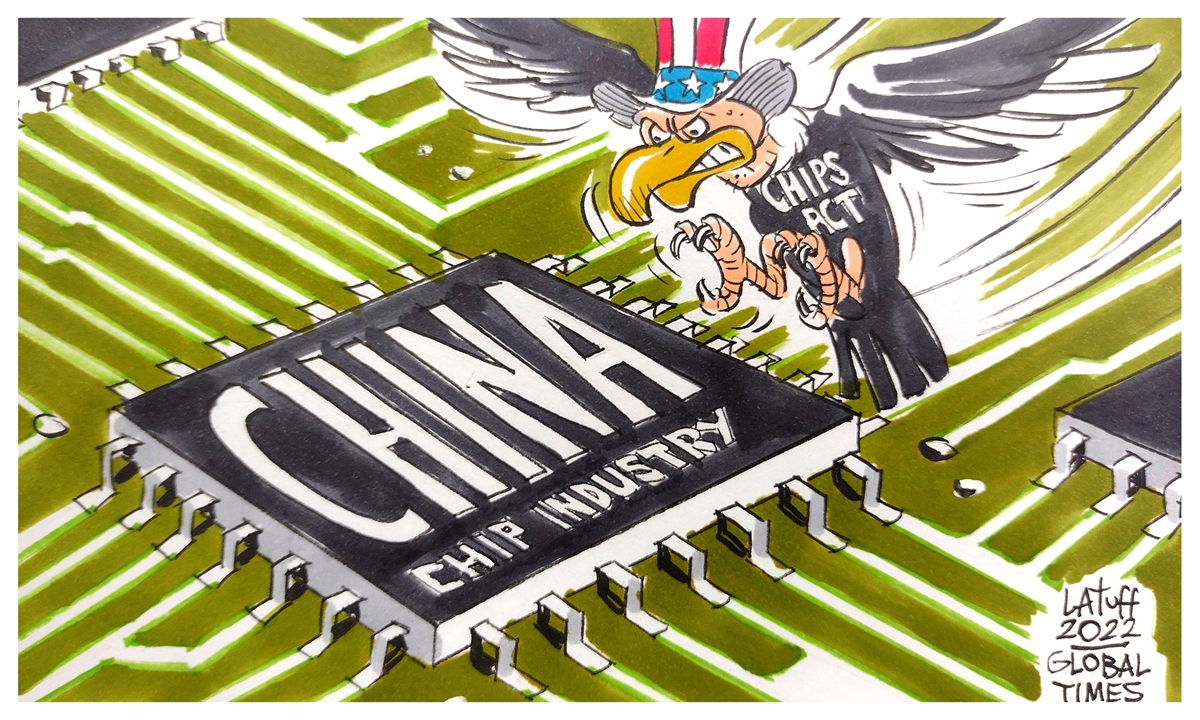
US claws at China's chip industry fanning flames on tech confrontation. Cartoon: Carlos Latuff
China's semiconductor industry has demonstrated a remarkable surge in self-innovation in recent years, particularly in the face of escalating sanctions and export restrictions imposed by the US. Rather than retreating in the wake of these challenges, Chinese chip manufacturers have accelerated their efforts toward domestic production, achieving significant advancements across various sub-sectors. This development not only highlights the resilience and innovative spirit of China's chip industry but also signals the failure of Washington's strategy to contain China's technological development.
The US spared China's top producer of dynamic random-access memory (DRAM) from its latest round of chip export restrictions because of opposition from Japan, the South China Morning Post reported on Friday, citing anonymous sources.
The news came several days after the US government last week announced a new round of export curbs on China, adding over 140 Chinese companies to the Commerce Department's entity list, involving various types of semiconductor products.
Whether the reported US exemption for the Chinese firm is true or not,it remains clear that the US has not wavered in its intention to suppress China's technological advancements. The fundamental logic leading the Chinese tech sector's response to this suppression has always been self-reliance and innovation, which is the reason behind the limitations of the US containment strategy and its inevitable failure.
The latest round of US export restrictions has targeted critical areas of semiconductor manufacturing equipment, such as coating and developing, etching, and thin-film deposition, which are precisely the strengths that China's chip industry has been striving to develop in recent years. It is the significant progress made by the Chinese chip industry in these key areas, coupled with its strengthening innovative capabilities, that has prompted the US to intensify its efforts to contain China's chip sector through blockades and suppression even more. However, this approach will not only fail to stop the advance of China's chip industry but will also stimulate even stronger motivation for independent innovation among Chinese chip companies.
Data from China's General Administration of Customs showed that in the first 10 months of 2024, China's total export value of integrated circuits reached 931.1 billion yuan ($128 billion), an increase of 21.4 percent year-on-year. This figure surpasses exports of automobiles, mobile phones, and home appliances.
More importantly, it signifies China's establishment of a complete domestic industrial chain and supporting facilities for chips above 7 nm, representing significant advancements made across various sectors, including design software, production equipment, chip design, wafer manufacturing, chip packaging, chip testing, chip materials, and industrial gases.
Over the years, the Chinese semiconductor industry has achieved breakthroughs through independent innovation, overcoming multiple technological bottlenecks and realizing leapfrog development from individual breakthroughs to advancements across comprehensive sub-sectors. And as time goes on, these breakthroughs will also extend into more advanced process areas and cutting-edge technology fields. For example, a team of Chinese scientists has designed a revolutionary artificial intelligence (AI) chip based on photonics instead of traditional electronic transistors, paving the way for large-scale photonic computing and efficient real-world AI applications, Xinhua reported in April.
Moreover, the challenges confronting the US chip containment strategy stem not only from China's growing innovation capabilities but also from the intricate cooperation and interdependence within the global industrial chain. The growing opposition from various countries' industries underscores the complexity and interconnectedness of the global chip industry. As China's chip sector continues to advance, its collaboration with the global industrial chain deepens, making it increasingly difficult for the US containment strategy to be effective.
Against this backdrop, independent innovation in China's chip industry is set to gain significant momentum. Although the US chip containment strategy has had an impact on China's chip development in the short term, in the medium to long term, it cannot hold back China's chip development, because China has already established a strong and extensive chip development foundation. With ongoing technological advancements and increasing market demand, China's innovation capabilities and market potential are expected to play an increasingly crucial role in global technological competition.
Global Times




